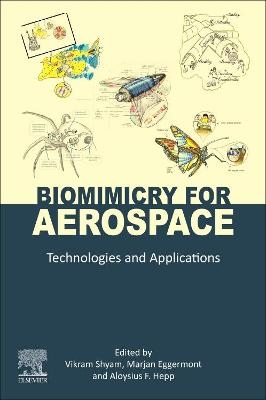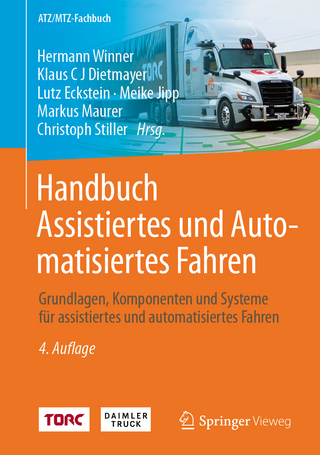
Biomimicry for Aerospace
Elsevier Science Publishing Co Inc (Verlag)
978-0-12-821074-1 (ISBN)
Readers will get a deep dive into the utility of biomimetics to solve a number of technical challenges in aeronautics and space exploration. Part I: Biomimicry in Aerospace: Education, Design, and Inspiration provides an educational background to biomimicry applied for aerospace applications. Part II: Biomimetic Design: Aerospace and Other Practical Applications discusses applications and practical aspects of biomimetic design for aerospace and terrestrial applications and its cross-disciplinary nature. Part III: Biomimicry and Foundational Aerospace Disciplines covers snake-inspired robots, biomimetic advances in photovoltaics, electric aircraft cooling by bioinspired exergy management, and surrogate model-driven bioinspired optimization algorithms for large-scale and complex problems. Finally, Part IV: Bio-Inspired Materials, Manufacturing, and Structures reviews nature-inspired materials and processes for space exploration, gecko-inspired adhesives, bioinspired automated integrated circuit manufacturing on the Moon and Mars, and smart deployable space structures inspired by nature.
Dr. Vikram Shyam is an adjunct professor at the University of Akron in the Mechanical Engineering department. He is also a research aerospace engineer who works as a futurist for NASA. He is the founder of the Virtual Interchange for Nature-Inspired Exploration (V.I.N.E.) at NASA's John H. Glenn Research Center. His interests include artificial intelligence, biomimicry, innovation design and futurology. Dr. Shyam is the recipient of NASA’s Presidential Early Career Award for Scientists and Engineers (PECASE). Dr. Marjan Eggermont is a Teaching Professor and faculty member at the University of Calgary in the Mechanical and Manufacturing department of the Schulich School of Engineering, University of Calgary. She is also the Academic Director for Sustainable Engineering. Dr. Eggermont teaches in the areas of graphics, engineering design, visualization, and biomimicry. She co-founded and designs Zygote Quarterly (ZQ), an online journal to provide a platform to showcase the nexus of science and design using case studies, news, and articles. In 2005, she was one of the recipients of the American Society of Mechanical Engineers Curriculum Innovation Award. She is a former board member of the American Society of Engineering Education. Aloysius F. Hepp is Chief Technologist at Nanotech Innovations and an independent consultant based in Cleveland, Ohio. He earned a PhD in Inorganic Photochemistry in 1983 from MIT and retired in December 2016 from the Photovoltaic & Electrochemical Systems Branch of the NASA Glenn Research Center (Cleveland). He was a visiting fellow at Harvard University from 1992–3. He was awarded the NASA Exceptional Achievement medal in 1997. He has served as an adjunct faculty member at the University of Albany and Cleveland State University. Dr. Hepp has co-authored nearly 200 publications (including six patents) focused on processing of thin film and nanomaterials for I–III–VI solar cells, Li-ion batteries, integrated power devices and flight experiments, and precursors and spray pyrolysis deposition of sulfides and carbon nanotubes. He has co-edited twelve books on advanced materials processing, energy conversion and electronics, biomimicry, and aerospace technologies. He is Editor-in-Chief Emeritus of Materials Science in Semiconductor Processing (MSSP) and is currently the chair of the International Advisory Board of MSSP, as well as serving on the Editorial Advisory Boards of Mater. Sci. and Engin. B and Heliyon. He has recently been appointed as Series Editor for the Vacuum and Thin-Film Deposition Technologies series and the Aerospace Fundamentals, Applications, and Exploration series.
Part 1: Biomimicry in aerospace: Education, design and inspiration 1. Biomimicry and bio-design for innovation in future space colonization 2. A bio-inspired design and space challenges cornerstone project 3. Periodic table of life: Systematic nature-inspired problem solving for aerospace applications and beyond 4. Parallels in communication, navigation technology, and natural phenomena 5. Atacama Desert: Genius of place
Part 2: Bio-inspired design: Aerospace and practical applications 6. Bio-inspired design and additive manufacturing of cellular materials 7. Biomimetic course design exploration for improved NASA zero gravity exercise equipment 8. Biomimicry of boxfish: Designing an aerodynamically efficient passenger car 9. Thresholds of nature: How understanding one of nature’s penultimate laws led to the PowerCone, a biomimetic energy source
Part 3: Biomimicry and foundational aerospace disciplines 10. Slithering across worlds snake-inspired robots for extraterrestrial exploration 11. Biomimetic advances in photovoltaics with potential aerospace applications 12. Electric aircraft cooling with bio-inspired exergy management 13. Surrogate model-driven bio-inspired optimization algorithms for large-scale and high-dimensional problems
Part 4: Bio-inspired materials, manufacturing and structures 14. Advancing research efforts in biomimicry to develop nature-inspired materials and processes for space exploration and more efficient aircraft 15. Space applications for gecko-inspired adhesives 16. Automated electronic integrated circuit manufacturing on the Moon and Mars: possibilities of the development of bioinspired semiconductor technology for space applications 17. Smart deployable space structures inspired by nature
| Erscheinungsdatum | 08.03.2022 |
|---|---|
| Zusatzinfo | 300 illustrations (50 in full color); Illustrations |
| Sprache | englisch |
| Maße | 152 x 229 mm |
| Gewicht | 810 g |
| Themenwelt | Technik ► Fahrzeugbau / Schiffbau |
| Technik ► Luft- / Raumfahrttechnik | |
| ISBN-10 | 0-12-821074-5 / 0128210745 |
| ISBN-13 | 978-0-12-821074-1 / 9780128210741 |
| Zustand | Neuware |
| Haben Sie eine Frage zum Produkt? |
aus dem Bereich


